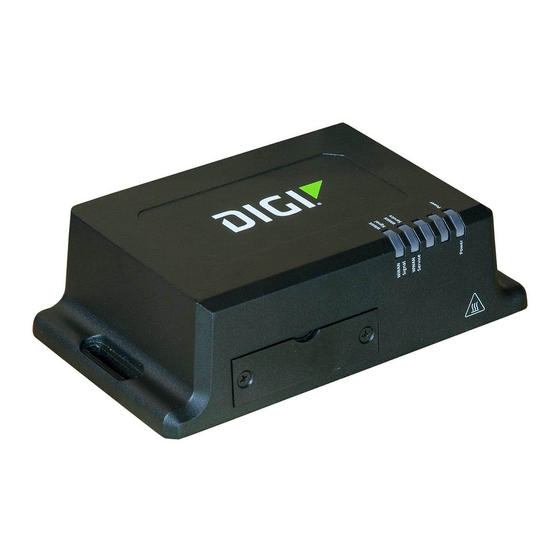
Digi IX14 Manuals
Manuals and User Guides for Digi IX14. We have 3 Digi IX14 manuals available for free PDF download: User Manual
Digi IX14 User Manual (828 pages)
Brand: Digi
|
Category: Network Router
|
Size: 11 MB
Table of Contents
-
Next Steps23
-
IX14 Leds26
-
Interfaces65
-
Delete a WWAN116
-
Configure a LAN120
-
Delete a LAN129
-
DHCP Servers131
-
Serial Port153
-
Local Users191
-
Ldap218
-
Firewall241
-
Packet Filtering255
-
Downgrading281
-
Configure DNS347
-
Show DNS Server353
-
SNMP Security354
-
Download Mibs359
-
Modbus Gateway389
-
System Time406
-
Learn more514
-
Intelliflow516
-
Ipsec529
-
Ipsec Mode529
-
Ipsec Modes529
-
Authentication530
-
Openvpn582
-
Show GRE Tunnels619
-
L2Tp635
-
L2TP with Ipsec653
-
L2Tpv3 Ethernet655
-
Nemo661
-
Show NEMO Status667
-
View System Logs672
-
View Event Logs674
-
IP Routing705
-
Routing Services719
-
Dynamic DNS725
-
Vrrp731
-
Configure VRRP732
-
Configure VRRP735
-
File System758
-
The Help Command776
-
Show Config782
-
Show System783
-
Show Network783
-
Analyzer Clear800
-
Analyzer Save801
-
Analyzer Start801
-
Analyzer Stop801
-
Container Create802
-
Container Delete802
-
Help802
-
Mkdir805
-
Modem at805
-
Modem Pin Change807
-
Modem Pin Enable807
-
Modem Pin Status808
-
Modem Pin Unlock808
-
Modem Puk Status808
-
Modem Puk Unlock808
-
Modem Reset809
-
Modem Scan809
-
Modem Sim-Slot809
-
Monitoring809
-
More810
-
Ping810
-
Reboot812
-
Scp814
-
Show Analyzer814
-
Show Arp814
-
Show Cloud814
-
Show Config815
-
Show Containers815
-
Show Dhcp-Lease815
-
Show Dns815
-
Show Event815
-
Show Hotspot816
-
Show Ipsec816
-
Show L2Tp Lac816
-
Show L2Tp Lns816
-
Show L2Tpeth817
-
Show Location817
-
Show Log817
-
Show Manufacture817
-
Show Modem818
-
Show Nemo818
-
Show Network818
-
Show Ntp818
-
Show Route819
-
Show Serial819
-
Show Scripts820
-
Show System821
-
Show Usb821
-
Show Version821
-
Show Vrrp821
-
Show Web-Filter821
-
Speedtest822
-
Ssh822
-
System Backup822
-
System Find-Me823
-
System Restore825
-
System Time Set827
-
System Time Sync827
-
System Time Test827
-
Telnet827
-
Traceroute828
Advertisement
Digi IX14 User Manual (338 pages)
Brand: Digi
|
Category: Network Router
|
Size: 2 MB
Table of Contents
-
-
Next Steps24
-
-
-
Local Users64
-
Firewall
90 -
-
Serial Port143
-
Services
147-
Configure DNS166
-
System Time176
-
Applications
190 -
-
Learn more224
-
Monitoring
225 -
Diagnostics
235-
File System252
-
Filesystem
253-
File System253
-
-
-
-
CE Mark (Europe)261
-
-
-
-
Show Config276
-
Show System277
-
Show Network277
-
-
-
-
Mkdir295
-
Modem at296
-
Modem Pin Change298
-
Modem Pin Enable300
-
Modem Pin Status301
-
Modem Pin Unlock302
-
Modem Puk Status303
-
Modem Puk Unlock304
-
Modem Reset305
-
Modem Sim-Slot306
-
More307
-
Ping309
-
Reboot310
-
Scp312
-
Show Arp313
-
Show Cloud314
-
Show Config315
-
Show Dhcp-Lease316
-
Show Event317
-
Show Ipsec318
-
-
Show Log319
-
Show Manufacture320
-
Show Modem321
-
Show Network322
-
Show Route325
-
Show Serial326
-
Show System327
-
Show Version328
-
Show Wifi Ap329
-
Show Wifi Client330
-
System Backup331
-
System Restore333
-
Traceroute335
-
Update Firmware338
Digi IX14 User Manual (74 pages)
Brand: Digi
|
Category: Network Router
|
Size: 1 MB
Table of Contents
-
Welcome
14 -
-
Next Steps26
-
-
-
-
Monitoring
61 -
Diagnostics
69
Advertisement
Advertisement


